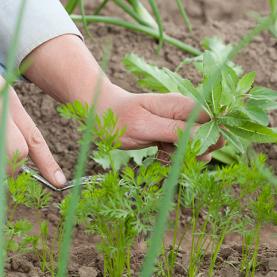Carrot
A biennial plant belonging to the Apiaceae family, the yellow or purple carrot was domesticated in Asia in the 10th century before being brought to Europe two centuries later. The orange variety emerged in the Netherlands in the 17th century and soon became popular. As a root, the carrot requires careful treatment against pests and diseases while growing but, once it reaches maturity, this makes it easier to harvest and preserve.
Carrots have a colourful history
Carrots originate from Iran and were was first domesticated in Asia in the 10th century. Naturally yellow or purple in colour, this root gradually became a common foodstuff in Asian regions.
Carrots were first consumed in Europe in the 12th century, but only in a limited manner, as parsnips were still widely eaten at the time. The orange carrots we know so well today only originated in the 17th century, produced by the Dutch following a cultural selection process. They soon became popular, then European colonisation introduced this root to the American continent. Today, although orange carrots are still the most popular, old-fashioned vegetables are making a comeback, bringing the yellow or purple carrots of yesteryear back to our tables.
Cultivating a root
Carrots are cultivated in three ways: in individual beds, raised mounds or directly in the ground. Carrots take two to three months to grow from sowing through to harvest. A sandy loam soil and a dry, cool climate with enhanced irrigation are necessary.
The seedlings must be planted in soil that has been tilled, turned over and aired. Their spacing determines the shape, size and colour of the plants when they reach maturity. Sufficient space enables the roots to develop and store a large amount of nutrients. For optimal production, carrots are cultivated in rotation, i.e. planted alternately with another edible vegetable.
There are several types of preventive treatments against diseases, parasites and pests to ensure the growth of this root vegetable. For example, regular weeding (by steam or by hand) removes weeds and residues from former harvests, and thus drives out insects.
Carrots are ready for harvesting when their roots appear at the surface and the green foliage is fully developed. As an underground root vegetable, carrots can be kept underground for a long time and without processing. They can thus be harvested (mechanically or by hand) as and when required.
Part of the Apiaceae family
Carrots belong to the Apiaceae family. Their stalks measure some 30 cm tall with small white flowers. A biannual plant, they grow slowly and are available in over 500 varieties.
Carrots are among the most commonly eaten winter vegetables, but are nonetheless available at markets all year long in both their natural and processed form (grated, pre-cooked, tinned, frozen, etc.).
Click here to add carrots to your Potionarium
BLOCH-DANO, Evelyne, 2008. La fabuleuse histoire des légumes. Paris : Éditions Grasset.
ISBN 9782246732198.
JEANGUYOT, Michelle et SÉGUIER-GUIS, Martine, 2004. L’herbier voyageur : histoire des fruits, légumes et épices du monde. Toulouse : Éditions Plume de carotte.
ISBN 9782951662971
PELT, Jean-Marie et STEFFAN, Franck, 2015. Légumes d’ailleurs et d’autrefois. Paris : Fayard.
ISBN 9782213683263
PITRAT, Michel et FOURY, Claude, 2015. Histoire de légumes : des origines à l’orée du XXe siècle. Paris : Éditions Quae.
ISBN 9782759223558.
CHAMBRE D’AGRICULTURE DE LOT-ET-GARONNE. La culture de la carotte bio en Lot et Garonne [en ligne]. Chambre d’agriculture de Lot-et-Garonne. [Consulté le 09 juillet 2015]. Disponible à l’adresse :






